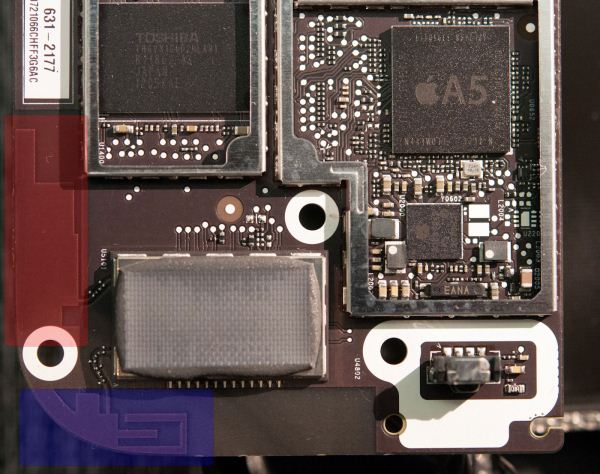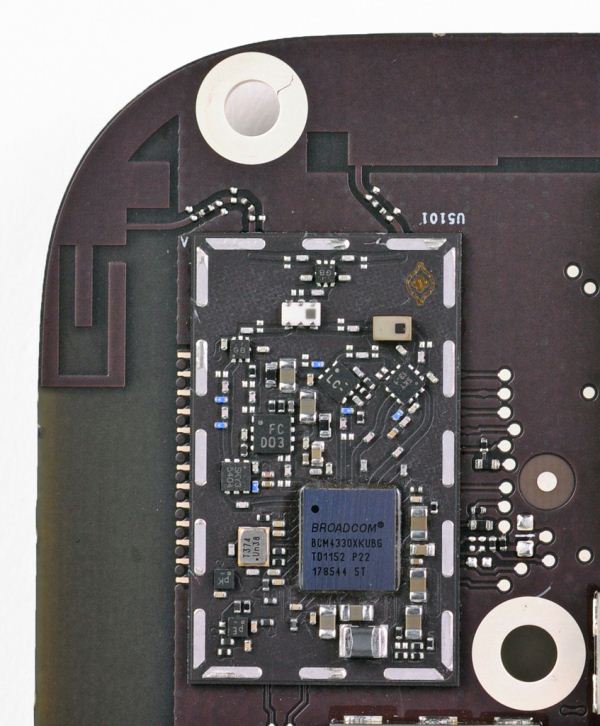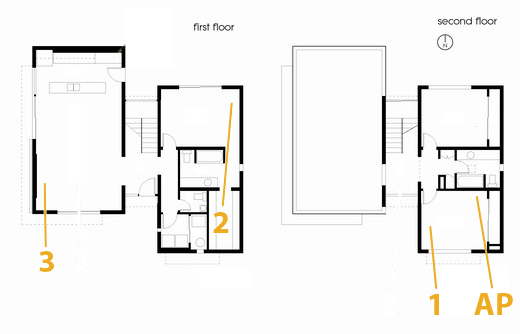Apple TV 3 (2012) Short Review - 1080p and better WiFi
by Brian Klug on March 21, 2012 4:21 PM ESTI touched on the fact that the Apple TV 3 now has two WiFi antennas printed on its PCB. The first appears to be of similar design to the Apple TV 2, and it's obvious from visual inspection that this is the case. The second is adjacent and shares the same ground plane / metal layer.

Antenna 1 (Encircled in blue), Antenna 2 (Encircled in red)
In addition, the Apple TV 3 also moves from Broadcom's BCM4329 802.11a/b/g/n and BT 2.0+EDR combo chip to BCM4330 802.11a/b/g/n and BT 4.0 combo chip which we've seen in the iPad 3, iPhone 4S, and countless other mobile devices. Seeing two RF chains, you might be led to think that the Apple TV 3 has 2x2:2, however this is not the case as the device still will only connect at 65 Mbps - single spatial stream, 20 MHz wide channels with the long guard interval. The maximum PHY rate and presence of 2.4 and 5 GHz band support is unchanged from Apple TV 2.

BCM4330 - Courtesy iFixit
One of the main complaints that I read online of the Apple TV 2 was its performance on 2.4 GHz. If you're living in the Apple ecosystem with an Airport Extreme or have a 5 GHz AP, this previously is something you could've not noticed entirely. In addition, multimedia streaming seems to be the ideal use case for 5 GHz WLAN thanks to both the ability to run 40 MHz channels and deal with less congestion. However, for users with 2.4 GHz networks, gain on that band is important.
It's obvious that the inclusion of a second WLAN chain and antenna is an attempt to improve RF performance further, even though the jump from 720p to 1080p for iTunes content doesn't increase bitrate very much at all (more later). To show just how much things have changed, I turned to the FCC documents for both Apple TV models which spell out antenna gain. Interestingly enough, the FCC also had internal photos up and posted the day the Apple TV 3 went on sale, which could've saved everyone some teardown time.
| Apple TV 2 and 3 - Antenna Gain | ||||||||
| Antenna | Apple TV 3 (A5) (BCGA1427) | Apple TV 2 (A4) (BCGA1378) | ||||||
| Band (MHz) | Ant 1 (dBi) | Ant 2 (dBi) | Ant 1 (dBi) | |||||
| 2400-2483.5 | 3.7 | - | 0.49 | |||||
| 5150-5120 | 4.5 | 2.4 | 2.76 | |||||
| 5250-5350 | 4.1 | - | 2.95 | |||||
| 5470-5725 | 4.5 | - | 4.09 | |||||
| 5745-5850 | 4.6 | - | 1.42 | |||||
The table above contains the antenna gains for both models, and you can immediately see just how little gain there was previously for the Apple TV 2 on 2.4 GHz. Gain is now majorly improved on the 2.4 GHz band, and also improved on other parts of the 5 GHz band. You'll notice that antenna 2 on the Apple TV 3 only gets used (at least for transmit) on the 5.2 GHz band - channels 36 to 48. This is the small band below the DFS-enabled 5 GHz band (52-140). Remember that the "best" 5 GHz channels in the USA are the traditional 802.11a channels 149-165 since you can run with higher power. BCM4330 supports optional external antenna diversity - it's entirely possible this is also being used on the receive side.
So what does this translate to in terms of actual RF performance now? To find out, I tested the Apple TV at three places in my house where I ran the previous model. Downstairs in my home theater shelf, a location which is awful for WiFi (I've run powerline here), downstairs in the bedroom (ironically on a 720p TV), and upstairs in my office on another TV right next to the AP for a baseline.

Location 1 corresponds to the office environment right next to the AP, location 2 is the bedroom TV, and location 3 is the main TV cabinet. I setup the Apple TV 2 and 3 in all three locations like I normally would and fired up the Netflix example short test videos to ensure constant network traffic. I then watched the received signal strength and noise metrics reported from an Airport Extreme 5th gen.
| Apple TV 2 and 3 - Antenna Gain | |||||||||||||
| Antenna | Apple TV 3 (A5) (BCGA1427) | Apple TV 2 (A4) (BCGA1378) | |||||||||||
| Location | Signal (dBm) | Noise (dB) | Rate (Mbps) | Band (GHz) | Signal (dBm) | Noise (dB) | Rate (Mbps) | Band (GHz) | |||||
| 1 - Office | -47 | -87 | 65 | 5 | -50 | -90 | 65 | 5 | |||||
| 2 - Bedroom | -71 | -90 | 65 | 2.4 | -78 | -90 | 58 | 5 | |||||
| 3 - Living Room | -69 | -85 | 65 | 2.4 | -80 | -90 | 52 | 5 | |||||
I have my network setup with one SSID for both 2.4 and 5 GHz networks, and let devices choose which band. The Apple TV 3 seems to have a higher affinity for 2.4 GHz in the more difficult downstairs propagation environments, no doubt which comes from it being able to negotiate a higher PHY rate on 2.4 GHz as opposed to 5 GHz. In all three places, it latches onto the single spatial stream 20 MHz channel long guard interval 65 Mbps rate, where the Apple TV 2 previously selected lower MCS categories on 5 GHz.
The takeaway is that the new Apple TV 3 gets better WiFi reception on both bands and thus can be placed further from the AP. This is something which no doubt will be much appreciated by users who have challenging home theater locations. Part of the reason is also no doubt to accommodate 1080p versus 720p content, though for iTunes content bitrate only changes from ~4 Mbps to ~5 Mbps. The other big new bandwidth consumer is of course iTunes Match. Obviously it goes without saying that Apple's media streamer device needs to have good connectivity to do its job, and the WiFi improvement makes a dramatic difference if you don't already have ethernet wherever you've located your TV.










37 Comments
View All Comments
Teeeee - Wednesday, March 21, 2012 - link
You didn't mention that when Mountain lion is used with AirPlay, that anything you could play on your Mac could be displayed via the apple tv, including previous downloaded shows and stuff in additional file formats or websites.Brian Klug - Thursday, March 22, 2012 - link
I've updated with a clearer mention. Admittedly I haven't gotten around to trying Mountain Lion out, however.-Brian
relentlessfocus - Wednesday, March 21, 2012 - link
I personally feel that Apple's strategy is to make the iPad and possibly the iPhone the real source for content with the AppleTV being only an iOS tv accessory. With 100 million iPads sometime in 2012 and a few hundred million iPhones its a nice accessory to have.Hulu I believe is on the iPad in the US, certainly here in the UK its possible to mirror the BBC's iPlayer to the AppleTV even though there isn't an AppleTV iPlayer app (yet). Bloomberg TV Airplays nicely to the AppleTV and Sky and other channels here in the UK are on the iPad. Given the complexity of digital rights its far easier for Apple to let the copyright owners make their own apps for the iPad than it is to work out deals with Apple as middleman via iTunes.
Fanfoot - Tuesday, March 27, 2012 - link
Well, sort of.On iOS Apple has allowed app developers to block mirroring to the Apple TV. For example, HBO Go and Hulu both do NOT allow mirroring on the iPad. So for the moment, an Apple TV isn't as good a TV streamer device as some others if you judge it simply on its abilities to play back HBO Go or Hulu Plus or whatever.
With Mountain Lion Apple seems to be taking a different stance, simply encoding whatever is on the display and since most viewing is done inside a browser, it isn't clear how/if any site will be able to block mirroring from working. Right now the working assumption is that sites like the free Hulu WILL work on Mountain Lion. Which may help to push things forward and stop this sort of behavior on iOS devices going forward.
ltcommanderdata - Wednesday, March 21, 2012 - link
"While most of the attention this previous week has been focused on Apple's A5X SoC inside the iPad (3rd Gen), the other Apple-SoC news is that of the S5L8942 or A5 revision 2 inside the Apple TV 3, and iPad2,4."In page 2 of the article you mention the iPad2,4? Where does this come from? Are you saying Apple quietly revved the iPad 2 when they dropped the price to $399? Hopefully not. With 1x512MB on a 1x32-bit memory bus in the new A5 versus 2x256MB on a 2x32-bit memory bus in the old A5, that would fragment the iPad 2 userbase with different performance profiles.
Brian Klug - Thursday, March 22, 2012 - link
The iPad2,4 reference comes from numerous configuration files/plist files in iOS 5.1. At this point I don't know if it's simply the iPad 2 R2 (aka cheapified iPad 2) or something else, and I think the jury is still out. Even so it's possible to just put a different memory device on top and maintain 2x32 (which I hope they've done) whereas the ATV3 just gets the 1x32 512 MB device.Again, I haven't seen that iPad out in the wild, but it definitely includes the same Apple SoC revision.
-Brian
ltcommanderdata - Thursday, March 22, 2012 - link
Maybe it's the much speculated iPad Mini? Personally, given Apple's talk of iPads in education and the learning potential that is there for students, I'm hoping it's a cut down education specific iPad 2 model. A single core A5 should be sufficient for iBook textbooks and learning games and selling it with dramatically reduced profit margin at say a $249 unit price would really drive school adoption. It won't be an immediate money maker for Apple, but early iOS familiarity can ripple into continued iOS customers as the kids grow up. All pure speculation of course.Morelian - Wednesday, March 21, 2012 - link
I've owned the Apple TV (2) for the past year or so and have found it a useful device. We have multiple Iphones and Ipads in the house so the airplay thingy is good, and the apple tv will get media off the windows pcs as well. In my house it is mostly used as the Netflix access device hooked up to the 52 inch hdtv. The Netflix app on the Apple TV is better than the one on the Sony Blueray player.The selling point to me is if you have other Apple products the device is handy but even if you don't, it still is a good buy if your TV doesn't have a Netflix player attached.
This review tells me I should get new Apple TV for the big TV and give the kids who have the little TV the old one :P
amagrude - Wednesday, March 21, 2012 - link
The remote is slightly different in the Apple TV v3. The top 4-way circle has a pronounced circle bulge along the inner circle. The v2 remote (and every other metal one I've used) was rounded smooth in the shape of the contour of the remote. I like the new feel better - easier to get your finger into the center of that 4-way switch w/o looking.Brian Klug - Thursday, March 22, 2012 - link
Weird, I bought my Apple TV 2 about halfway into its product cycle, so I think I might've just gotten the updated remote.Compare if you will the Apple TV 2 and 3 remote (the 2 is the one with small dents/scuffs from where I've dropped it) in the gallery: http://www.anandtech.com/Gallery/Album/1822#13
http://www.anandtech.com/Gallery/Album/1822#12
-Brian